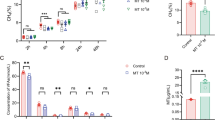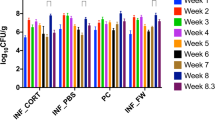Abstract
Fecal prevalence of Escherichia coli O157 in ruminants is highest in the summer decreasing to very low levels in the winter. We hypothesize that this seasonal variation is a result of physiological responses within the host animal to changing day-length. To determine the effects of melatonin (MEL) on fecal shedding of E. coli O157:H7 in cattle, eight crossbred beef steers identified as shedding E. coli O157:H7, were allotted to treatment: control or MEL (0.5 mg/kg body weight (BW); 1×) administered orally daily for 7 days. After a 5-day period of no treatment, a second MEL dose (5.0 mg/kg BW; 10×) was administered daily for 4 days. Fecal samples were collected daily for qualification of E. coli O157:H7. No differences (P > 0.10) were observed in the percentage of E. coli O157:H7 positive fecal samples in steers receiving the 1× MEL dose, however the 10× dose decreased (P = 0.05) the percentage of fecal samples E. coli O157:H7 positive. Serum MEL concentrations were higher in the 1×, but not 10×, treated animals compared to control animals. Although it is difficult to explain, this may be a result of decreasing day-length increasing serum melatonin concentrations that may have masked any treatment effect on serum melatonin. In a second similar experiment, a second group of cattle (heifers and steers) were administered tryptophan (TRP) over a 17-day experimental period (5 g/head/day for 10 days followed by 10 g/head/day for 7 days). Tryptophan had no effect (P > 0.20) on the percentage of fecal samples positive for E. coli O157. Serum TRP (P < 0.05), but not MEL (P > 0.20), concentrations were elevated in TRP-treated animals. The decrease in the number of positive fecal samples observed in the first experiment, may be related to gastrointestinal MEL, affected by the 10×, but not 1× MEL dose.


Similar content being viewed by others
References
Ayles HL, Ball RO, Friendship RM, Bubenik GA (1996) The effect of graded levels of melatonin on performance and gastric ulcers in pigs. Can J Anim Sci 76:607–611
Barkocy-Gallagher GA, Arthur TM, Rivera-Betancourt M, Nou X, Shackelford SD, Wheeler TL, Koohmaraie M (2003) Seasonal prevalence of Shiga toxin-producing Escherichia coli, including O157:H7 and non-O157 serotypes, and Salmonella in commercial beef processing plants. J Food Prot 66:1978–1986
Benouali S, Sarda N, Gharib A, Roche M (1993) Implication of melatonin in the control of the interdigestive ileocecal-colic electromyographic profile in rats. C R Acad Sci III 316:524–528
Besser RE, Griffin PM, Slutsker L (1999) Escherichia coli O157:H7 gastroenteritis and the hemolytic uremic syndrome, an emerging infectious disease. Annu Rev Med 50:355–367
Bubenik GA (2002) Gastrointestinal melatonin. Localization, function, and clinical relevance. Dig Dis Sci 47:2336–2348
Bubenik GA (2001) Localization, physiological significance and possible clinical implication of gastrointestinal melatonin. Biol Signals Recept 10:350–366
Bubenik GA, Pang SF, Hacker RR, Smith PS (1996) Melatonin concentrations in serum and tissues of porcine gastrointestinal tract and their relationship to the intake and passage of food. J Pineal Res 21:251–256
Bubenik GA (1980) Localization of melatonin in the digestive tract of the rat: effect of maturation, diurnal variation, melatonin treatment, and pinealectomy. Horm Res 12:313–323
Bubenik GA, Niles LP, Pang SF, Pentney PJ (1993) Diurnal variation and binding characteristics of melatonin in the mouse brain and gastrointestinal tissues. Comp Biochem Physiol C 104:221–224
Carlson JR, Yokoyama MT, Dickinson EO (1972) Induction of pulmonary edema and emphysema in cattle and goats with 3-methylindole. Science 176:298
Capriola A, Morabito S, Brugere H, Oswald E (2005) Enterohaemorrhagic Escherichia coli: emerging issues on virulence and modes of transmission. Vet Res 36:289–311
Chapman PA, Siddons CA, Cerdan malo AT, Harkin MA (1997) A 1-year study of Escherichia coli O157 in cattle, sheep, pigs and poultry. Epidemiol Infect 119:245–250
Cho HC, Pang SF, Chen WB, Pfeifer CJ (1989) Modulating effect of melatonin on serotonin-induced aggravation of ethanol ulceration and changes of mucosal blood flow in the rat stomach. J Pineal Res 6:89–97
Edrington TS, Callaway TR, Hallford DM, Anderson RC, Nisbet DJ (2007) Influence of exogenous triiodothyronine (T3) on fecal shedding of Escherichia coli O157 in cattle. Microb Ecol 53:664–669
Edrington TS, Callaway TR, Ives SE, Engler MJ, Looper ML, Anderson RC, Nisbet DJ (2006) Seasonal shedding of Escherichia coli O157:H7 in ruminants: A new hypothesis. Foodborne Pathog Dis 3:413–421
Griffin PM, Tauxe RV (1991) The epidemiology of infections caused by Escherichia coli O157:H7, other enterohemorrhagic E. coli, and the associated hemolytic uremic syndrome. Epidemiol Rev 13:60–98
Hajak G, Rodenbeck A, Ehrenthal HD, Leonard S, Wedekind D, Sengos G, Zhou D, Huether G (1997) No evidence for a physiological coupling between melatonin and glucocorticoids. Psychopharmacology 133:313–322
Hancock DD, Besser TE, Rice DH, Herriott DE, Tarr PI (1997) A longitudinal study of Escherichia coli O157 in fourteen cattle herds. Epidemiol Infect 118:193–195
Huether G (1993) The contribution of extrapineal sites of melatonin synthesis to circulating melatonin levels in higher vertebrates. Experientia 49:665–670
Huether G, Poeggeler B, Reimer A, George A (1992) Effect of tryptophan administration on circulating melatonin levels in chicks and rats: evidence for stimulation of melatonin synthesis and release in the gastrointestinal tract. Life Sci 51:945–953
Huether G, Hajak G, Reimer A, Poeggeler R, Blomer M, Rodenbeck A, Ruther E (1992) The metabolic fate of infused l-tryptophan in men: possible clinical implications of the accumulation of circulating tryptophan and tryptophan metabolites. Psychopharmacology 106:422–432
Jawaorek J, Nawrot K, Konturek SJ, Leja-Szpak A, Thor P, Pawlik WW (2004) Melatonin and its precursor, l-tryptophan: influence on pancreatic amylase secretion in vivo and in vitro. J Pineal Res 36:155–164
Kay S (2003) The cost of E. coli O157:H7. Meat Poult 2:26–34
Kennaway DJ, Firth RG, Phillipou G, Mathews CD, Seamark RF (1977) A specific radioimmunoassay for melatonin in biological tissue and fluids and its validation by gas chromatography–mass spectrometry. Endocrinology 101:119–127
Khan R, Daya S, Potgieter B (1990) Evidence for the modulation of the stress response by the pineal gland. Experientia 46:860–862
Kvetnoy IM, Ingel IE, Kvetnaia TV, Malinovskaya NK, Rapoport SI, Raikhlin NT, Trofimov AV, Yuzhakov VV (2002) Gastrointestinal melatonin: cellular identification and biological role. Neuro Endocrinol Lett 23:121–132
Lee PP, Pang SF (1993) Melatonin and its receptors in the gastrointestinal tract. Biol Signals 2:181–193
Lee PP, Shiu SY, Chow PH, Pang SF (1995) Regional and diurnal studies of melatonin and melatonin binding sites in the duck gastro-intestinal tract. Biol Signals 4:212–224
Legan SJ, Karsch FJ (1979) Neuroendocrine regulation of the estrous cycle and seasonal breeding in the ewe. Biol Reprod 20:74–85
Lerner A, Case J, Takahashi J (1958) Isolation of melatonin, the pineal gland factor that lightens melanocytes. J Am Chem Soc 80:2587–2589
Lewinski A, Rybicka I, Wajs E, Szkudlinski M, Pawlikowski M (1991) Influence of pineal indolamines on the mitotic activity of gastric and colonic mucosa epithelial cells in the rat: interaction with omeprazole. J Pineal Res 10:104–108
Lyte M, Frank CD, Green BT (1996) Production of an autoinducer of growth by norepinephrine cultured Escherichia coli O157:H7. FEMS Microbiol Lett 139:155–159
Midgley J, Desmarchelier P (2001) Pre-slaughter handling of cattle and Shiga toxin-producing Escherichia coli (STEC). Lett Appl Microbiol 32:307–311
Nelson RJ, Drazen DL (1999) Melatonin mediates seasonal adjustments in immune function. Reprod Nutr Dev 39:383–398
Ozaki Y, Lynch HJ (1976) Presence of melatonin in plasma and urine of pinealectomized rats. Endocrinology 99:641–644
Rangel JM, Sparling PH, Crowe C, Griffin PM, Swerdlow DL (2005) Epidemiology of Escherichia coli O157:H7 outbreaks, United States, 1982–2002. Emerg Infect Dis 11:603–609
Rasmussen MA, Casey TA (2001) Environmental and food safety aspects of Escherichia coli O157:H7 infections in cattle. Crit Rev Microbiol 27:57–73
Rice J, Mayor J, Tucker HA, Beilski RJ (1995) Effect of light therapy on salivary melatonin in seasonal affective disorder. Psychiatry Res 56:221–228
Schultz CL, Edrington TS, Callaway TR, Schroeder SB, Hallford DM, Genovese KJ, Anderson RC, Nisbet DJ (2006) The influence of melatonin on growth of E. coli O157:H7 in pure culture and exogenous melatonin on faecal shedding of E. coli O157:H7 in experimentally infected wethers. Lett Appl Microbiol 43:105–110
Sperandio V, Torres AG, Jarvis B, Nataro JP, Kaper JB (2003) Bacteria–host communication: the language of hormones. Proc Natl Acad Sci USA 100:8951–8956
Sugden D, Namboodiri MAA, Klein DC, Grady RlK Jr, Mefford IN (1985) Ovine pineal indoles: effects of l-tryptophan or l-5-hydroxytryptophan administration. J Neurochem 44:769–772
Talley NJ (1992) Review article: 5-hydroxytryptamine agonists and antagonists in the modulation of gastrointestinal motility and sensation: clinical implications. Aliment Pharmacol Ther 6:273–289
Vakkuri O, Rintamaki H, Leppaluoto J (1985) Presence of immunoreactive melatonin in different tissues of the pigeon (Columba livia). Gen Comp Endocrinol 58:69–75
Van Donkersgoed J, Graham T, Gannon V (1999) The prevalence of verotoxins, Escherichia coli O157:H7 and Salmonella in the feces and rumen of cattle at processing. Can Vet J 40:332–338
Weissbluth L, Weissbluth M (1992) Infant colic: the effect of serotonin and melatonin circadian rhythms on the intestinal smooth muscle. Med Hypotheses 39:164–167
Yaga K, Reiter RJ, Richardson BA (1993) Tryptophan loading increases daytime serum melatonin levels in intact and pinealectomized rats. Life Sci 52:1231–1238
Acknowledgements
This research was funded in part by beef and veal producers and importers through their $1-per-head checkoff and was produced for the Cattlemen’s Beef Board and state beef councils by the National Cattlemen’s Beef Association. The authors gratefully acknowledge Graham Land and Cattle Company, Gonzales, TX for their participation in this research.
Author information
Authors and Affiliations
Corresponding author
Rights and permissions
About this article
Cite this article
Edrington, T.S., Callaway, T.R., Hallford, D.M. et al. Effects of Exogenous Melatonin and Tryptophan on Fecal Shedding of E. Coli O157:H7 in Cattle. Microb Ecol 55, 553–560 (2008). https://doi.org/10.1007/s00248-007-9300-8
Received:
Revised:
Accepted:
Published:
Issue Date:
DOI: https://doi.org/10.1007/s00248-007-9300-8




